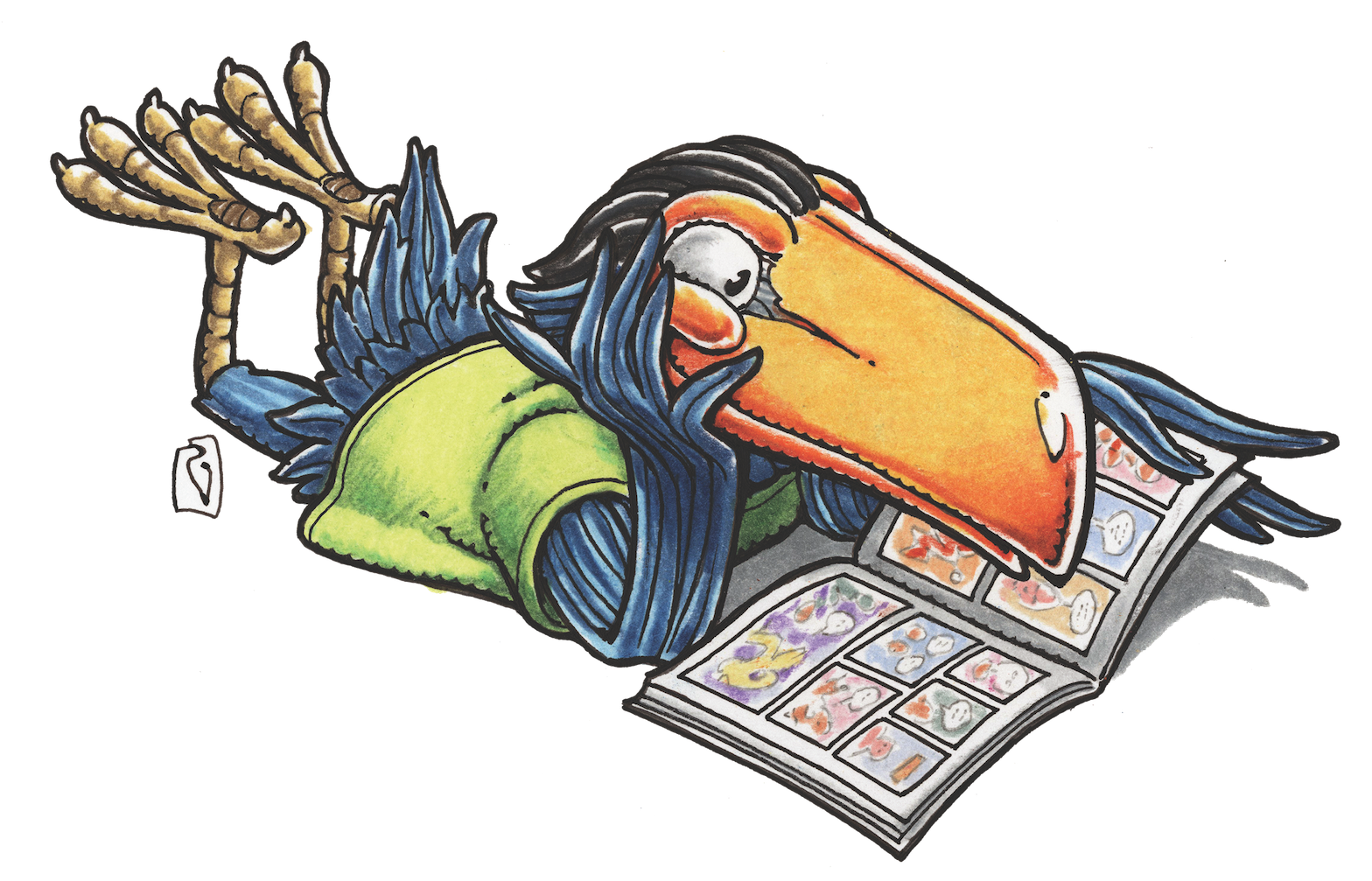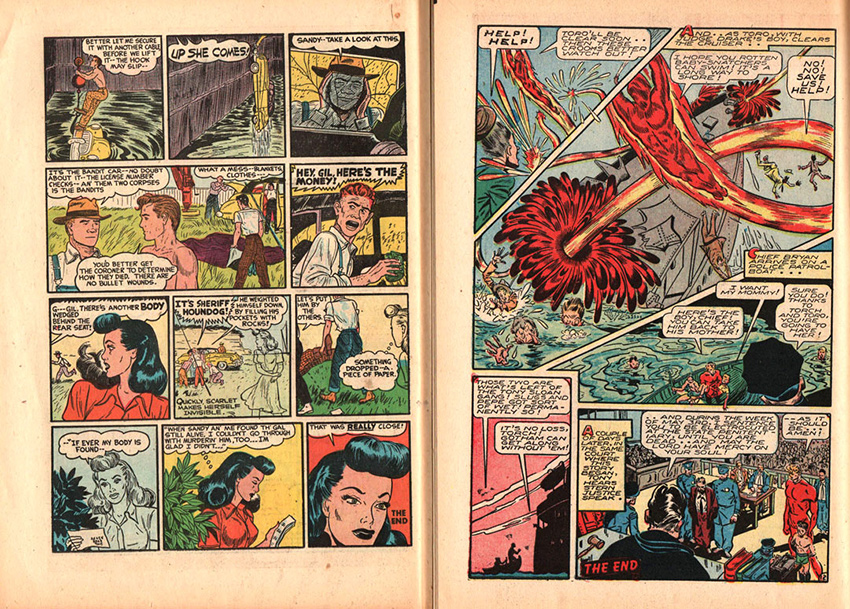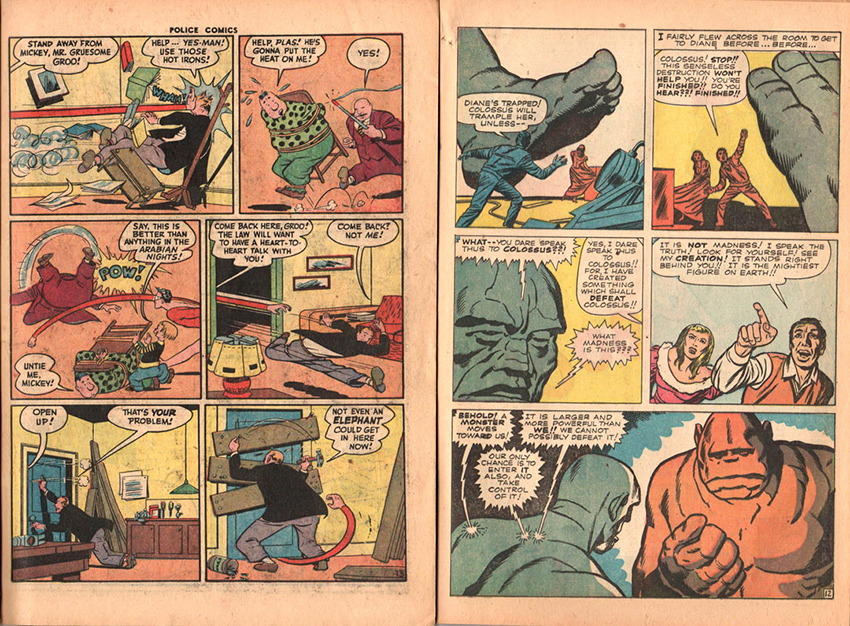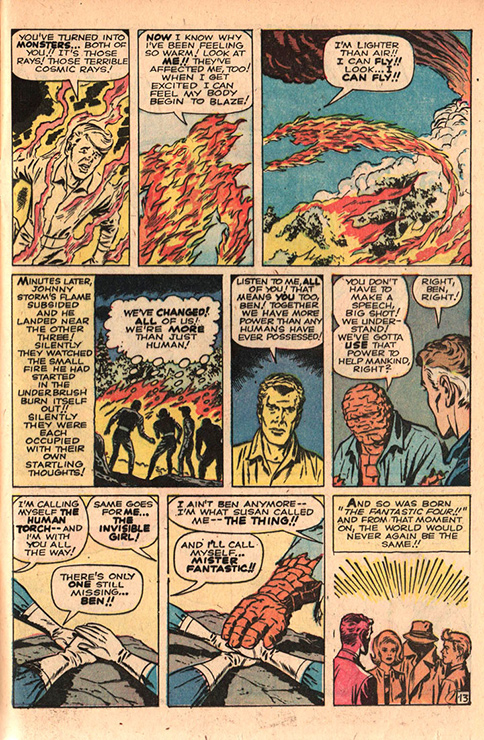MAGGIE’S WORLD BY MAGGIE THOMPSON
Maggie’s World 046: Retreads

Travel back with me now … back … back … back … 55 years …
Autumn 1961
School had started. Among the attention-getting new series released then was one cover-dated November. How did some of us react?
Well, when Don and I prepared the second issue of our Comic Art, in the issue’s closing remarks, Don wrote a brief couple of paragraphs headed “The Current Scene.” They read:
“[In Showcase #34 (September 1961)] DC has revived, in totally different form, yet another old-time costume hero, ‘The Atom.’ This version owes more to ‘Dollman’ than the old ‘Atom.’ I no like.

“Joe [Yeah, ouch!] Kirby and Stan Lee have revived, again in different form, ‘The Human Torch,’ with this version appearing as part of ‘The Fantastic Four’ in a comic book of that title. Other members: Mister Fantastic (derived, minus humor, from Plastic Man), Invisible Girl (similar to Invisible Scarlet O’Neil) and The Thing (derived from the current crop of comic book monsters). I don’t like this one, either.”
So there you are. As comics fandom was beginning to get under way, we were not overwhelmed by some of the attempts to revitalize super-heroes for a new generation. Darn that Joe Kirby, anyway.
Retreads
Invisible Scarlet O’Neil
Created, written, and drawn by former Chester Gould assistant Russell Stamm, the daily newspaper strip began June 3, 1940. In a laboratory event, O’Neil became invisible but developed a way of turning visible again—and quickly began to have more adventures. Historian Ron Goulart commented, “An invisible heroine might have been an opportunity to save on drawing for some, but not Stamm. He drew Scarlet even when she was not supposed to be seen, making her seem more transparent than invisible.” Her newspaper adventures continued into the mid-1950s.
The Human Torch
Marvel Comics #1 (October 1939) cover-featured a threatening Human Torch by Frank R. Paul, but the story—created, written, and drawn by Carl Burgos—introduced the character as a science-created android who soon figured out a way to control his flame. Within a year (in a story also by Burgos), The Torch got a human kid sidekick (named Toro), who just happened to be able to burst into flame. Adventures ensued with some moments of hiatus until about 1954.

Plastic Man
Police Comics #1 (August 1941) introduced a number of characters, among them Plastic Man in a story created, written, and drawn by Jack Cole. Eel O’Brian was a crook, who, soaked in acid, developed the ability to stretch and turned over a new leaf to fight crime. His morphing ability was often used for gags—his identity usually revealed to the reader by the retention of a red outfit with a black-and-yellow belt. The last issue of Quality’s Plastic Man was #64 (November 1956).
Kirby Monsters
When did they start? Late 1950s? I’m not going to try to nail it down. They didn’t go away, of course, but they morphed in service of the new team.
Onward!
Mind you, we’d worked past some of that initial dislike and had mellowed a bit by our next issue, produced a few months later. “Jack Kirby, whose co-creative efforts are discussed by Herb Beach in this issue, has teamed up with Stan Lee to produce some singularly uninspired comic books dealing with trite monsters with ridiculous names such as Krag, Gorm and (so help me) Fin Fang Foom. Jumping on the bandwagon, they have created two comics dealing with super-heroes. The first, The Fantastic Four was panned here last issue. The panning is reaffirmed, albeit more mildly. Despite the fact that two of the four title characters (Mr. Fantastic and Invisible Girl) are less than useless, a sharp improvement in the characterizations of The Thing and The Human Torch brings the book to the fringe of readability. Bringing back the Sub-Mariner helped, too.” We weren’t blown away by the second Marvel superhero series—The Hulk—so there’s that. (In contrast, Don singled out the second and third tryouts for The Atom for praise and suggested three other DC characters worth following: Green Lantern, The Flash, and Hawkman.)

Heck, even the concept of the FF itself was a retread of putting together a team of an assortment of differently powered supers. It came more than two decades after a bunch of superheroes in DC’s All-Star Comics finally joined forces after getting to know each other.
It was clearly a time of retreads. Superman had been introduced in 1938 and had evolved but without a break, but a new version of The Flash had sped into the Silver Age in 1956—introducing reboots fewer than two decades after superheroes first became A Comic-Book Thing.
The advantage of producing a retread is that the creators can pick what they consider the best aspects of what has gone before; the disadvantage is that the readers may gripe that the new creators have Messed Things Up.
The More Things Change …
It’s been going on for a long time. Even the Golden Age itself had accustomed comics fans to a certain amount of variation in tales with which they were familiar. When Frank Coghlan turned into Tom Tyler in Republic’s Adventures of Captain Marvel, kids in the know in 1941 accepted Billy Batson’s meeting Shazam in the course of an expedition to Siam—rather than in a city subway system. And that was only about a year after Whiz Comics had brought him to newsstands, regularly reiterating the “how” and “why” of his origin.
So it is that, while some among today’s critics may complain that the white character shouldn’t be rebooted as black, the old mystical Asian guy shouldn’t be played by a younger-looking white woman, the— Yeah, I could just go on. Anyway, we long-timers got used to these sorts of changes more than half a century ago.
So here’s to 55 years of the FF—and to the retreads waiting to entertain us in the future!
Maggie’s World by Maggie Thompson appears the first Tuesday of every month here on Toucan!